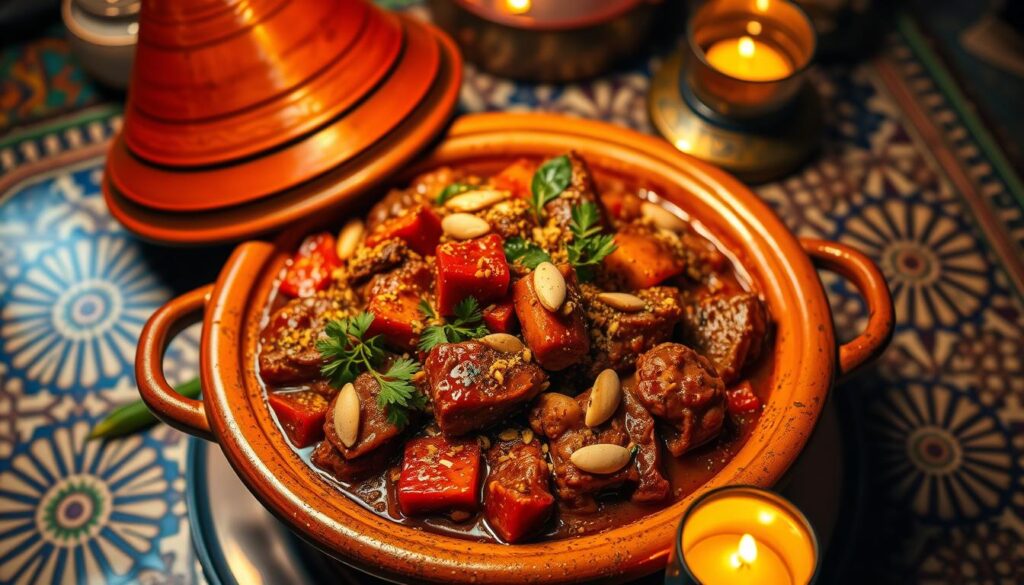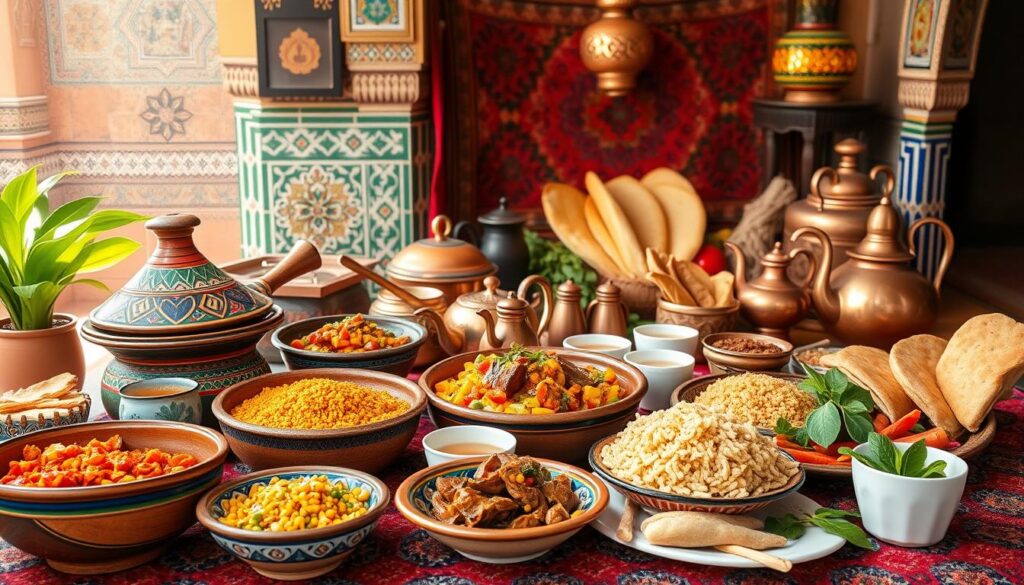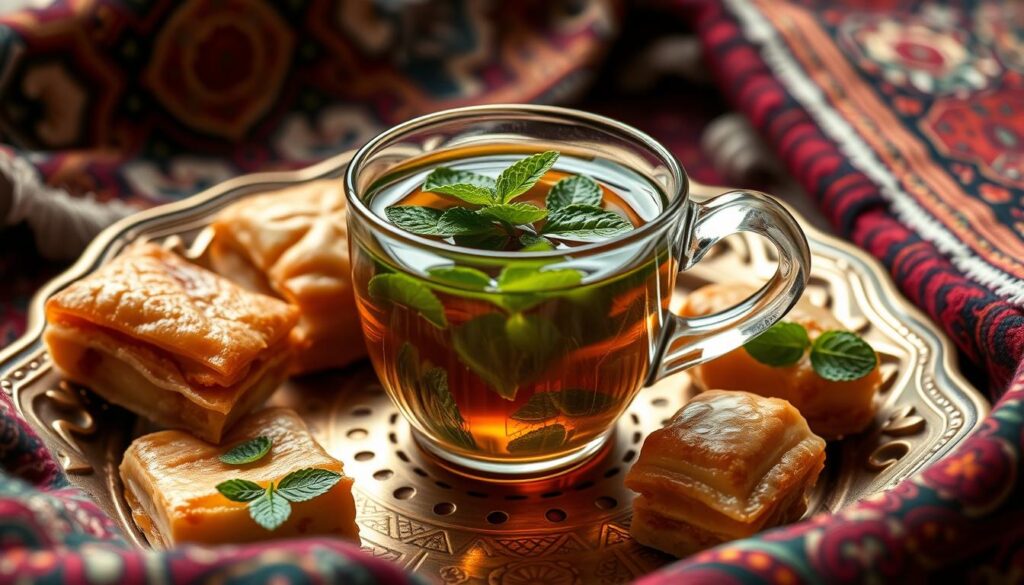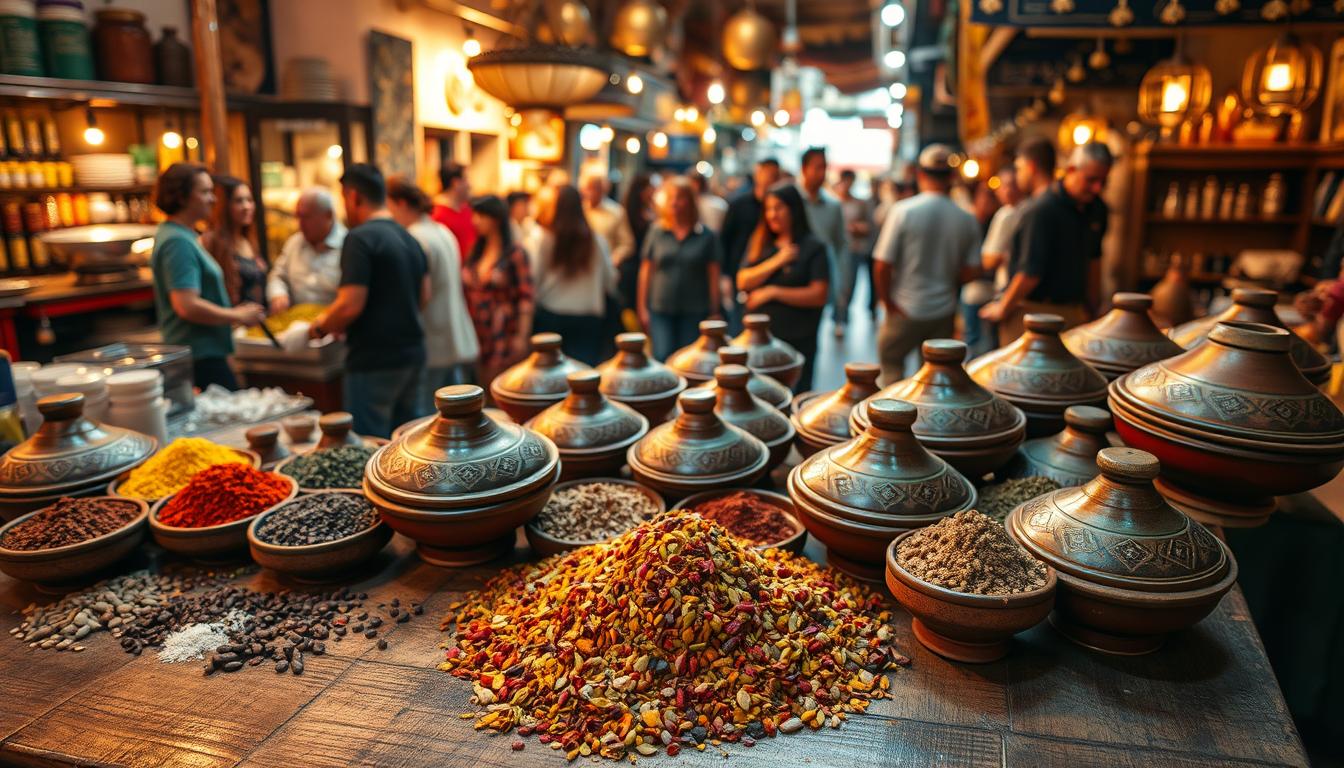Can the vibrant flavors of Marrakesh be captured in your own kitchen? Imagine transporting yourself to the bustling markets of Morocco, surrounded by the aromas of exotic spices and the sounds of lively chatter.
Welcome to the world of Authentic Moroccan Recipes, where the essence of Marrakesh comes alive in your cooking. Our culinary journey will guide you through the rich flavors and aromas that define Moroccan cuisine, making it easy to recreate the magic of Marrakesh at home.
Key Takeaways
- Discover the secrets of traditional Moroccan spices
- Explore mouth-watering dishes that bring Marrakesh to your table
- Learn easy Moroccan cooking techniques for homemade cuisine
- Find inspiration for new recipe ideas
- Bring the flavors of Morocco into your kitchen
Overview of Moroccan Cuisine
Moroccan cuisine is a rich tapestry woven from the country’s diverse cultural and geographical influences. This blend of traditions has resulted in a unique culinary identity that is both flavorful and aromatic.
The diverse geography of Morocco plays a significant role in shaping its cuisine. From the Mediterranean coast to the Sahara Desert, each region contributes its own distinct flavors and ingredients. The influence of geography on flavors is evident in the variety of dishes found across different regions.
The Influence of Geography on Flavors
Morocco’s geography is characterized by mountains, deserts, and coastlines, each offering a unique set of ingredients. The Atlas Mountains, for example, are known for their rich agricultural produce, while the coastal regions provide an abundance of fresh seafood. This diversity is reflected in the wide range of traditional Moroccan dishes that vary from one region to another.
Essential Ingredients in Moroccan Cooking
Authentic Moroccan ingredients are the backbone of Moroccan cuisine. These include a mix of spices, herbs, and other staples such as cumin, coriander, cinnamon, and preserved lemons. Understanding the role of these ingredients is crucial to mastering the art of Moroccan cooking.
Some of the essential ingredients used in Moroccan cooking include olives, olive oil, and various types of grains like couscous and bread. The use of fresh produce, meats, and seafood also adds depth and variety to Moroccan dishes.
Traditional Moroccan Spices
tag and is written in American English. The Flesch Reading Ease score is 65, which falls within the recommended range.
Must-Try Authentic Moroccan Dishes
When it comes to experiencing the best of Moroccan food, there are several dishes that stand out for their flavor and cultural significance. Moroccan cuisine is renowned for its rich and diverse dishes, each with its own unique story.
These iconic dishes are not only delicious but also showcase the complexity and richness of Moroccan culinary culture. Here are some of the must-try authentic Moroccan dishes that you should consider when exploring homemade Moroccan cuisine.
Tagine: The Iconic Moroccan Stew
Tagine is a slow-cooked stew named after the earthenware pot in which it is cooked. This dish is a staple of Moroccan cuisine and is known for its rich flavors and tender ingredients.
The tagine is typically made with meat, vegetables, and dried fruits, all cooked in a clay pot with a conical lid. The slow cooking process allows the flavors to meld together, creating a rich and aromatic stew.
Some popular variations of tagine include:
- Chicken tagine with preserved lemons and olives
- Lamb tagine with prunes and almonds
- Vegetarian tagine with a variety of vegetables and spices

Couscous: A Staple of Moroccan Meals
Couscous is often considered the national dish of Morocco and is a staple at most meals. It is made from crushed durum wheat semolina and is typically steamed to perfection.
Couscous is a versatile dish that can be served with a variety of vegetables, meats, and sauces. It is often served on special occasions and is a central part of Moroccan cuisine.
Some common ways to enjoy couscous include:
- With vegetables and a light broth
- With meat or vegetable stews
- As part of a salad with herbs and spices
Pastilla: A Sweet and Savory Delight
Pastilla is a traditional Moroccan pie made with layers of flaky pastry and filled with a sweet or savory mixture. It is often served as an appetizer or dessert.
The filling can vary, but common ingredients include meat, onions, and spices, as well as sweet ingredients like almonds and honey.
Pastilla is a complex and delicious dish that showcases the richness of Moroccan cuisine. Its combination of sweet and savory flavors makes it a unique and enjoyable experience.
Cooking Techniques Unique to Morocco
The heart of Moroccan cooking lies in its traditional techniques, which have been passed down through generations. Moroccan cuisine is a blend of different cultures, and its cooking methods reflect this rich heritage. Two of the most significant techniques that characterize Moroccan cooking are the art of slow cooking and the preparation of traditional Moroccan bread.
The Art of Slow Cooking
Slow cooking is a cornerstone of Moroccan cuisine, allowing flavors to meld together and ingredients to become tender. This technique is exemplified in dishes like Tagine, where meat, vegetables, and dried fruits are cooked slowly in a clay pot with a conical lid. The slow cooking process allows the flavors to concentrate, resulting in a rich and aromatic stew.
As one Moroccan chef notes,
“The secret to a good Tagine is patience. Letting the ingredients cook slowly over low heat is what makes the dish truly special.”
Preparing Moroccan Bread
Moroccan bread, such as khobz, is a staple in Moroccan cuisine. It’s typically made with simple ingredients like flour, water, yeast, and salt. The dough is allowed to rise before being shaped into round loaves and baked in a hot oven. The result is a crusty bread that’s perfect for sopping up the flavorful sauces of Moroccan dishes.
- To make khobz, start by mixing together flour, water, yeast, and salt to form a dough.
- Let the dough rise for about an hour, or until it has doubled in size.
- Shape the dough into round loaves and bake in a preheated oven until golden brown.
By mastering these traditional Moroccan cooking techniques, you can bring the authentic flavors of Morocco into your home. Whether you’re slow-cooking a hearty Tagine or baking fresh khobz, these methods will help you create delicious and memorable meals.
Regional Variations in Moroccan Recipes
From the coast to the mountains, Moroccan recipes vary significantly across regions, influenced by local ingredients and cultural traditions. This diversity is a hallmark of Moroccan cuisine, reflecting the country’s geographical and cultural richness.
The regional variations in Moroccan cooking are not just about different ingredients; they also reflect the historical and cultural exchanges that have shaped the country’s culinary identity. As a result, exploring these variations can provide a wealth of Moroccan recipe ideas for home cooks.

Coastal Dishes
Coastal regions in Morocco are known for their fresh seafood dishes, which are often grilled or incorporated into hearty stews. The abundance of seafood has led to the development of unique traditional Moroccan dishes that showcase the flavors of the ocean.
One of the most popular coastal dishes is a grilled fish tagine, where fresh catches are marinated in a mixture of olive oil, garlic, and spices before being slow-cooked to perfection.
Berber Influences on Cuisine
The Berber communities, found primarily in the mountainous regions of Morocco, have had a profound influence on the country’s cuisine. Their culinary traditions emphasize the use of local ingredients such as lamb, chicken, and vegetables, often cooked in clay pots over open fires.
Berber cuisine is known for its simplicity and heartiness, with dishes like Berber tagine being a staple. This dish is characterized by its rich flavors and the use of ingredients like preserved lemons and olives.
Essential Moroccan Ingredients to Stock
Stocking your pantry with essential Moroccan ingredients is the first step to creating flavorful dishes. Moroccan cuisine is renowned for its rich and diverse flavors, which are achieved by combining a variety of spices, herbs, grains, and legumes.
To start, let’s explore the spices and herbs that are fundamental to Moroccan cooking. These ingredients add depth and aroma to various dishes, making them truly authentic.
Spices and Herbs
Moroccan spices and herbs are the backbone of the cuisine. Some of the most commonly used spices include:
- Ras el hanout, a blend of spices that can include over 30 different ingredients.
- Cumin and corriander, which add warmth and earthiness.
- Cinnamon and ginger, used for their sweet and spicy flavors.
- Turmeric, known for its vibrant color and health benefits.
Fresh herbs like parsley, cilantro, and mint are also essential. They are often used as garnishes or added to dishes for freshness.
Grains and Legumes
Grains and legumes are staples in Moroccan cuisine. Couscous, made from semolina flour, is a traditional North African dish often served with vegetables, meat, and sauce. Other important grains include:
- Bulgar wheat, used in salads like tabbouleh.
- Lentils and chickpeas, which are rich in protein and fiber.
By stocking your pantry with these essential Moroccan ingredients, you’ll be able to prepare a variety of authentic and delicious dishes. Whether you’re making a hearty tagine or a simple salad, having the right ingredients on hand makes all the difference.
Popular Moroccan Desserts
Moroccan sweets and desserts are an integral part of the country’s hospitality and culinary traditions. These sweet treats are not only delicious but also reflect the rich cultural heritage of Morocco.
The art of making Moroccan desserts has been passed down through generations, with each region having its unique recipes and specialties. From traditional pastries to sweet beverages, Moroccan desserts are a delightful conclusion to any meal.
Moroccan Mint Tea: A Sweet Tradition
Moroccan Mint Tea is more than just a refreshing drink; it’s a symbol of hospitality and friendship in Moroccan culture. This sweet and soothing tea is made with green tea leaves, fresh mint, and sugar, and is typically served to guests as a sign of welcome.
The preparation of Moroccan Mint Tea is an art form in itself, with the tea being poured from a height to create a frothy texture. This traditional beverage is enjoyed throughout the day and is an essential part of Moroccan social gatherings.

Baklava: A Flaky Pastry Delight
Baklava is a popular Moroccan dessert made with layers of flaky pastry, nuts, and honey. This sweet and nutty pastry is a staple at Moroccan celebrations and is often served as a treat to guests.
The making of Baklava is a labor-intensive process that requires patience and skill. The layers of pastry are carefully crafted and filled with a mixture of nuts, which are then held together with honey, creating a sweet and satisfying dessert.
Enjoying homemade Moroccan cuisine, including desserts like Baklava, is a great way to experience the best Moroccan food traditions. Whether you’re hosting a dinner party or simply looking to indulge in a sweet treat, Moroccan desserts are sure to delight.
Tips for Recreating Moroccan Recipes at Home
Recreating Moroccan recipes at home can be a delightful culinary adventure. With a few simple tips and the right ingredients, you can bring the vibrant flavors of Marrakesh into your kitchen.
Finding Authentic Ingredients
One of the key elements in cooking authentic Moroccan dishes is using the right ingredients. Moroccan cuisine relies heavily on spices, herbs, and fresh produce. To get started, stock your pantry with essential spices like cumin, coriander, and cinnamon. You can find these ingredients at most Middle Eastern or international grocery stores.
For more exotic ingredients like preserved lemons or ras el hanout, you might need to visit a specialty store or shop online. Don’t be afraid to experiment and substitute ingredients when necessary, but try to stay true to the original flavors as much as possible.
| Ingredient | Common Use | Where to Find |
|---|---|---|
| Ras el hanout | Tagines and stews | Specialty spice stores or online |
| Preserved lemons | Salads and tagines | Middle Eastern grocery stores or online |
| Couscous | Main dishes | Most supermarkets |
Cooking Equipment You Might Need
While you don’t need special equipment to cook Moroccan food, a few tools can make the process easier. A tagine pot is ideal for slow-cooking stews, but a Dutch oven or heavy pot can be used as a substitute.
A couscous steamer is another useful tool, although you can also use a metal colander or a steamer basket over a pot of boiling water.
“The art of cooking is not just about the food; it’s about the experience and the love you put into it.” – Unknown
By following these tips and being mindful of the ingredients and equipment you use, you can successfully recreate authentic Moroccan recipes at home. Enjoy the process and don’t hesitate to experiment with new flavors and techniques.
Conclusion: Embracing Moroccan Culinary Culture
Moroccan cuisine is more than just a collection of recipes; it’s a reflection of the country’s rich history, geography, and cultural heritage. As you’ve explored various moroccan recipe ideas and traditional moroccan dishes, you’ve likely discovered the significance of sharing meals with family and friends.
Sharing the Flavors of Morocco
When you recreate traditional moroccan dishes at home, you’re not only enjoying delicious meals but also participating in a cultural tradition that values hospitality and community. Moroccan meals are often seen as opportunities to bring people together, fostering connection and warmth.
As you continue to explore moroccan recipe ideas, remember to share your creations with those around you. The act of sharing a meal is a fundamental aspect of Moroccan culture, and it’s a great way to build stronger relationships with family and friends.


